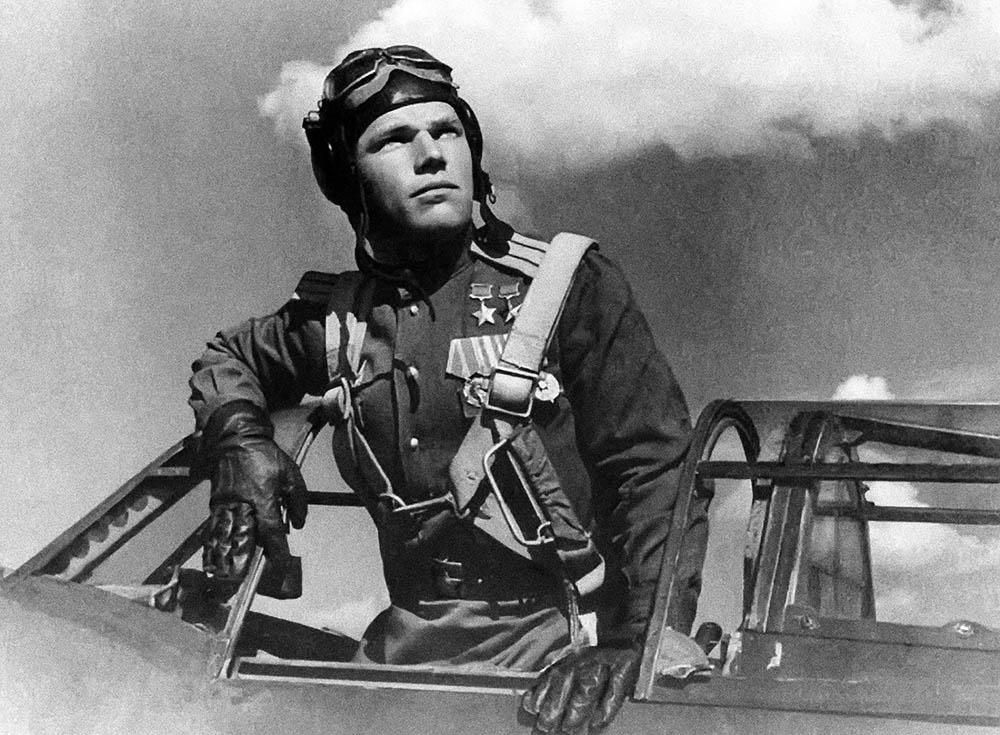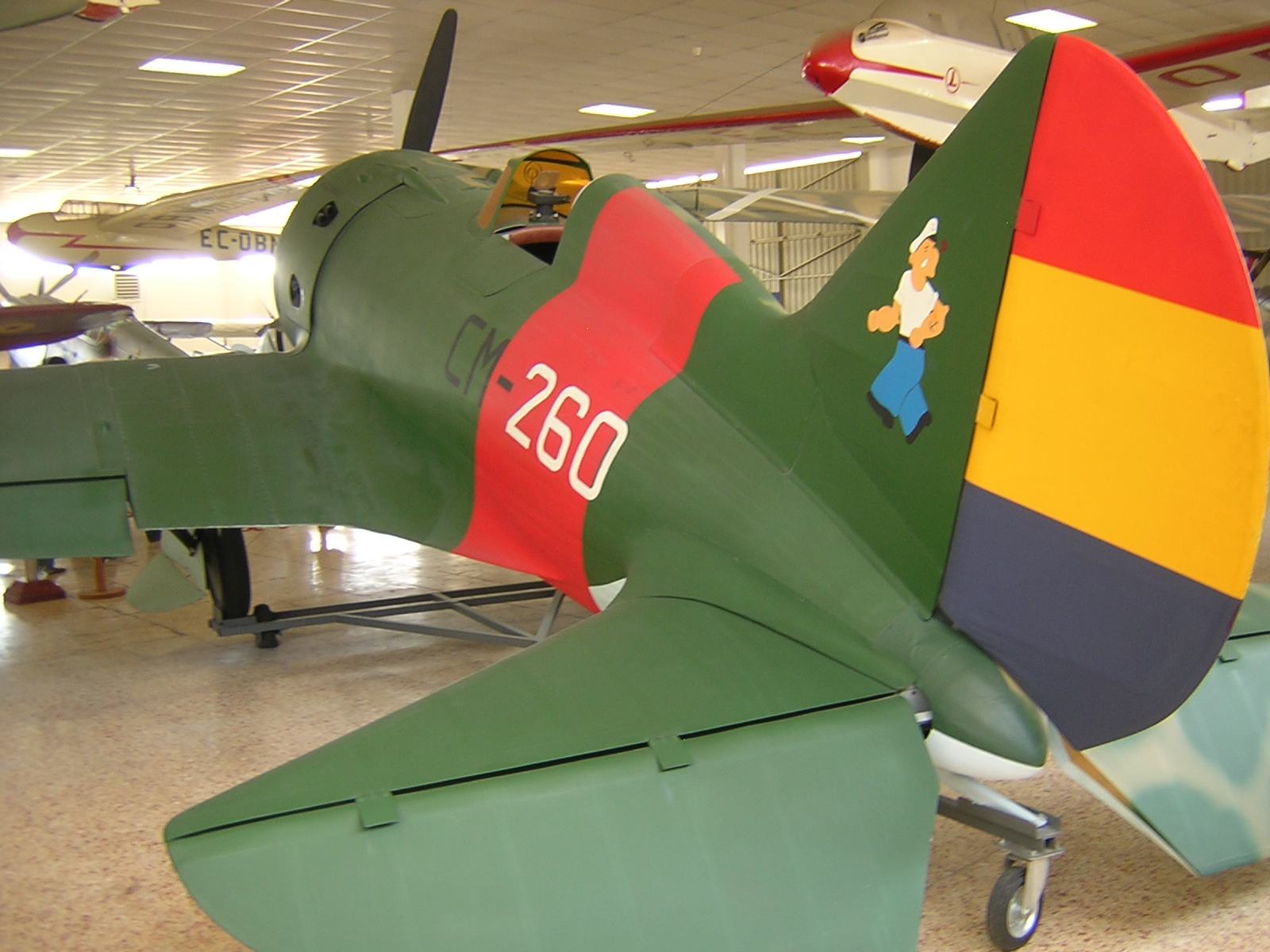|
Ivan Nikitovich Kozhedub
Marshal of Aviation Ivan Nikitovich Kozhedub (; ; 8 June 1920 – 8 August 1991) was a career aviator with the Soviet Air Forces who first came to prominence as a World War II fighter ace. Universally credited with over 60 solo victories, he is considered to be the highest scoring Soviet and Allied fighter pilot of World War II. Kozhedub is one of the few pilots confirmed to have shot down a Messerschmitt Me 262 jet, and the first Soviet pilot to have done so. He was made a Hero of the Soviet Union on three occasions (4 February 1944, 19 August 1944, and 18 August 1945). After World War II, he remained in the military and went on to command the 324th Fighter Aviation Division during Soviet operations in the Korean War. During the remainder of his military career, Kozhedub accumulated additional titles as a deputy of the Supreme Soviet of the USSR (1946-1962) and as Chairman of the Federation of Aviation Sports (1967-1987). He was promoted to Marshal of Aviation in 1985 and retire ... [...More Info...] [...Related Items...] OR: [Wikipedia] [Google] [Baidu] |
Obrazhiivka
Obrazhiivka (; ) is a village in , Shostka Raion, Sumy Oblast, Ukraine. Notable residents * Ivan Kozhedub, Hero of the Soviet Union * Pyotr Bochek Pyotr Semyonovich Bochek, (; 3 March 1925 – 9 February 2018) was a junior lieutenant of the Soviet Army during World War II and a Hero of the Soviet Union. He was born in the Obrazhiivka village, Ukrainian SSR. He was drafted in November 1943 ..., Hero of the Soviet Union References {{Sumy-geo-stub Villages in Shostka Raion ... [...More Info...] [...Related Items...] OR: [Wikipedia] [Google] [Baidu] |
Novodevichy Cemetery
Novodevichy Cemetery () is a cemetery in Moscow. It lies next to the southern wall of the 16th-century Novodevichy Convent, which is the city's third most popular tourist site. History The cemetery was designed by Ivan Mashkov and inaugurated in 1898. Its importance dates from the 1930s, when the necropolises of the medieval Muscovite monasteries (Simonov Monastery, Simonov, Danilov Monastery, Danilov, Donskoy Monastery, Donskoy) were scheduled for demolition. Only the Donskoy survived the Joseph Stalin era relatively intact. The remains of many famous Russians buried in other abbeys, such as Nikolai Gogol and Sergey Aksakov, were disinterred and reburied at the Novodevichy. A 19th-century necropolis within the walls of the Novodevichy convent, which contained the graves of about 2000 Russian noblemen and university professors, also underwent reconstruction. The vast majority of graves were destroyed. It was at that time that the remains of Anton Chekhov were moved outside the ... [...More Info...] [...Related Items...] OR: [Wikipedia] [Google] [Baidu] |
Ivan Kozhedub 1
Ivan () is a Slavic male given name, connected with the variant of the Greek name (English: John) from Hebrew meaning 'God is gracious'. It is associated worldwide with Slavic countries. The earliest person known to bear the name was the Bulgarian Saint Ivan of Rila. It is very popular in Russia, Ukraine, Croatia, Serbia, Bosnia and Herzegovina, Slovenia, Bulgaria, Belarus, North Macedonia, and Montenegro and has also become more popular in Romance-speaking countries since the 20th century. Etymology Ivan is the common Slavic Latin spelling, while Cyrillic spelling is two-fold: in Bulgarian, Russian, Macedonian, Serbian and Montenegrin it is , while in Belarusian and Ukrainian it is . The Old Church Slavonic (or Old Cyrillic) spelling is . It is the Slavic relative of the Latin name , corresponding to English ''John''. This Slavic version of the name originates from New Testament Greek (''Iōánnēs'') rather than from the Latin . The Greek name is in turn derived fr ... [...More Info...] [...Related Items...] OR: [Wikipedia] [Google] [Baidu] |
Voronezh Front
The 1st Ukrainian Front (), previously the Voronezh Front (), was a major formation of the Red Army during World War II, being equivalent to a Western army group. They took part in the capture of Berlin, the capital of Nazi Germany. Wartime The Voronezh Front was established at the end of June 1942 when tanks of the 6th Army of the German ''Wehrmacht'' reached Voronezh during the early stages of Operation Blau. It was split off the earlier Bryansk Front in order to better defend the Voronezh region. The name indicated the primary geographical region in which the front first fought, based on the town of Voronezh on the Don River. The Voronezh Front participated in the Battle of Voronezh, the defensive operations on the approaches to Stalingrad, and in the December 1942 Operation Saturn, the follow-on to the encirclement of the German 6th Army at Stalingrad where it destroyed the Hungarian Second Army. Following Operation Saturn, the front was involved in Operati ... [...More Info...] [...Related Items...] OR: [Wikipedia] [Google] [Baidu] |
Operation Barbarossa
Operation Barbarossa was the invasion of the Soviet Union by Nazi Germany and several of its European Axis allies starting on Sunday, 22 June 1941, during World War II. More than 3.8 million Axis troops invaded the western Soviet Union along a front, with the main goal of capturing territory up to a line between Arkhangelsk and Astrakhan, known as the A-A line. The attack became the largest and costliest military offensive in history, with around 10 million combatants taking part in the opening phase and over 8 million casualties by the end of the operation on 5 December 1941. It marked a major escalation of World War II, opened the Eastern Front—the largest and deadliest land war in history—and brought the Soviet Union into the Allied powers. The operation, code-named after the Holy Roman Emperor Frederick Barbarossa ("red beard"), put into action Nazi Germany's ideological goals of eradicating communism and conquering the western Soviet Union to repopulate it w ... [...More Info...] [...Related Items...] OR: [Wikipedia] [Google] [Baidu] |
Shymkent
Shymkent (, ; ) is a city in southern Kazakhstan, located near the border with Uzbekistan. It holds the status of a city of republican significance, one of only three cities in Kazakhstan with this distinction, alongside Almaty and Astana. As of June 2018, Shymkent had an estimated population of 1,002,291, making it the third-most populous city in the country, after Almaty and Astana. Shymkent serves as a regional cultural and economic center. It is situated approximately 690 kilometers (430 miles) west of Almaty and 1,483 kilometers (920 miles) south of Astana, with a strategic location 120 kilometers (75 miles) to the north of Tashkent, Uzbekistan. Its proximity to Uzbekistan contributes to its importance as a trade and cultural hub in the region. The city is connected by Şymkent International Airport, Shymkent International Airport serving as a key gateway for domestic and international flights. The city is also a major railway hub, with Shymkent railway station providing con ... [...More Info...] [...Related Items...] OR: [Wikipedia] [Google] [Baidu] |
Polikarpov I-16
The Polikarpov I-16 () is a Soviet single-engine single-seat fighter aircraft of revolutionary design; it is a low-wing cantilever monoplane fighter with retractable landing gear, and the first such aircraft to attain operational status. It "introduced a new vogue in fighter design".Green, William. "Polikarpov's Little Hawk". ''Flying Review'', November 1969. The I-16 was introduced in the mid-1930s and formed the backbone of the Soviet Air Force at the beginning of World War II. The diminutive fighter, nicknamed "''Ishak''" or "''Ishachok''" ("donkey" or "burro") by Soviet pilots, figured prominently in the Second Sino-Japanese War,Liss 1966, p. 10. the Battle of Khalkhin Gol, Winter War and the Spanish Civil War – where it was called the ("rat") by the Nationalists or (" fly") by the Republicans. The Finns called the aircraft "(flying squirrel)". Design and development While working on the Polikarpov I-15 biplane, Nikolai Nikolaevich Polikarpov began desig ... [...More Info...] [...Related Items...] OR: [Wikipedia] [Google] [Baidu] |
Chuhuiv
Chuhuiv () or Chuguev () is a city in Kharkiv Oblast, Ukraine. The city is the Capital (political), administrative center of Chuhuiv Raion (district). It hosts the administration of Chuhuiv urban hromada, one of the hromadas of Ukraine. Population: February 2024, according to the city council, more than 30 thousand people live in Chuhuiv. Chuhuiv's food industry focuses on producing mayonnaise along with other staple supporting condiments. History The City's founding date is disputed with historical assertions ranging from 1540 to 1627. Some academics believe that the city was built upon the orders Russia's first Tsar Ivan the Terrible who reigned from 1547 to 1584. A military fort was built adjacent to the city in 1638 by Ukrainian Cossacks of Yakiv Ostryanyn (see Ostryanyn uprising) on the order of Muscovite Tsar Mikhail Fedorovich. A military presence of some form near Chuhuiv has remained ever since. The Chuguev uprising of 1819 was a revolt of military settlers. During the ... [...More Info...] [...Related Items...] OR: [Wikipedia] [Google] [Baidu] |
Shostka
Shostka (, ) is a city in Sumy Oblast, northeastern Ukraine. Shostka serves as the administrative center of Shostka Raion. Population: The city lies on the Shostka River, a tributary of the Desna (river), Desna, from which it gets its name. Shostka is an important centre of industry: in chemicals (see Svema) and in dairy, the Shostka City Milk Plant was recently acquired by the Bel Group. History In 1739, a gunpowder factory was built there. Since that time, Shostka was one of the most important gunpowder suppliers in the Russian Empire. In 1893, a branch of a nearby railroad line was built. Shostka was granted city status, municipal rights in 1920. In 1931, a film factory was built in Shostka which was one of the main suppliers of cinema and photo film in the USSR. During the 2022 Russian Invasion of Ukraine, Shostka was besieged by Russian troops on February 24. and may have been partially occupied. During the withdrawal from the Chernihiv Oblast and Sumy Oblast, Russian tro ... [...More Info...] [...Related Items...] OR: [Wikipedia] [Google] [Baidu] |
Sumy Oblast
Sumy Oblast (), also known as Sumshchyna (), is an oblast (province) in northeast Ukraine. The oblast was created in its modern-day form, from the merging of raions from Kharkiv Oblast, Chernihiv Oblast, and Poltava Oblast in 1939 by the Presidium of the Supreme Soviet of the Soviet Union. The estimated population is The administrative center of the oblast is the city of Sumy. Other important cities within the oblast include Konotop, Okhtyrka, Romny, and Shostka. The modern region combines territories of the historical Severia (northern part) and Sloboda Ukraine (southern part). On territory of the Sumy Oblast important centers of Ukrainian culture are located, such as the city of Hlukhiv which served as a hetman residence during the Cossack Hetmanate as well as the cities of Okhtyrka and Sumy which were regional centers of the Sloboda Ukraine. The oblast has a heavy mix of agriculture and industry, with over 600 industrial locations. Among the most notable was the So ... [...More Info...] [...Related Items...] OR: [Wikipedia] [Google] [Baidu] |
Ukraine
Ukraine is a country in Eastern Europe. It is the List of European countries by area, second-largest country in Europe after Russia, which Russia–Ukraine border, borders it to the east and northeast. Ukraine also borders Belarus to the north; Poland and Slovakia to the west; Hungary, Romania and Moldova to the southwest; and the Black Sea and the Sea of Azov to the south and southeast. Kyiv is the nation's capital and List of cities in Ukraine, largest city, followed by Kharkiv, Odesa, and Dnipro. Ukraine's official language is Ukrainian language, Ukrainian. Humans have inhabited Ukraine since 32,000 BC. During the Middle Ages, it was the site of early Slavs, early Slavic expansion and later became a key centre of East Slavs, East Slavic culture under the state of Kievan Rus', which emerged in the 9th century. Kievan Rus' became the largest and most powerful realm in Europe in the 10th and 11th centuries, but gradually disintegrated into rival regional powers before being d ... [...More Info...] [...Related Items...] OR: [Wikipedia] [Google] [Baidu] |


